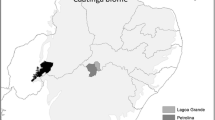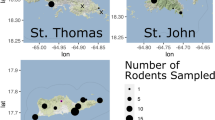Abstract
Leptospirosis is a zoonosis of global distribution, caused by the infection of pathogenic Leptospira, a group of bacteria capable of infecting both domestic and wild animals. Mink (Neovison vison) in southern Chile is recognized as a wild and synanthropic rodent predator (among various other prey), and Leptospira infection in them can be acquired through contact with the pathogen in the environment or by eating infected prey. Thus, the aim of this study was to provide more specifics regarding the source of the infection for the American mink under the conditions of Southern Chile. Minks were captured in the Los Ríos region, southern Chile, in an area with well-developed dairy farming. Two areas were selected for mink trapping, one with a high degree of dairy farming and a second with a low degree of dairy farming. Within them, 16 study sites were visited, and 45 American mink were trapped and euthanized to obtain kidney tissue and blood serum samples for bacteria isolation and determination of antibodies titers, respectively. Molecular characterization of the isolated strains was performed. Three minks from sites of high-dairy farming industry and only one from sites with low-degree dairy farming were detected as infected through molecular confirmation. This study shows evidence that confirms previous findings made in southern Chile, regarding mink as host of Leptospira interrogans serovar Hardjo-prajitno associated to cattle-farming areas. However, typing information (Leptospira interrogans Copenhageni and Icterohaemorrhagiae) suggests that the consumption of rodents may also be a potential source of infection.

Similar content being viewed by others
References
Adler, B., de la Peña, A. 2010. Leptospira and leptospirosis, Vet Microbiol,140, 287-296
Barros, M., Sáenz, L., Lapierre, L., Nuñez, C., Medina-Vogel, G. 2014. High prevalence of pathogenic Leptospira in alien American mink (Neovison vison) in Patagonia, Rev. Chil. Hist. Nat, 87,19
Bertasio, C. , Boniotti, M.B., Lucchese, L., Ceglie, L., Bellinati, L., Mazzucato, M., Furlanello, T., D’Incau, M. Natale, Alda. 2020 Detection of New Leptospira Genotypes Infecting Symptomatic Dogs: Is a New Vaccine Formulation Needed? Pathogens, 9, 484.
Cilia, G., Bertelloni, F., Angelini, M., Cerri, D., Fratini, F. 2020. Leptospira Survey in Wild Boar (Sus scrofa) Hunted in Tuscany, Central Italy. Pathogens, 9, 377.
Cosson, J.F., Picardeau, M., Mielcarek, M., Tatard, C., Chaval, Y. 2014. Epidemiology of Leptospira Transmitted by Rodents in Southeast Asia, PLoS Negl Trop Dis, 8, e2902
Cunningham, A.A., Daszak, P., Rodriguez, J.P. 2003. Pathogen pollution: defining a parasitological threat to biodiversity conservation, J Parasitol, 89, S78-S83
Daszak P., Cunningham, A.A., Hyatt, A.D. 2000. Emerging infectious diseases of wildlife-threats to biodiversity and human health, Science, 287, 443-449
Derne, B.T., Fearnley, E.J., Lau, C.L., Paynter, S., Weinstein, P. 2011. Biodiversity and leptospirosis risk: A case of pathogen regulation? Med Hypothesis, 77, 339-344
Ellis, W. 1994. Leptospirosis as a cause of reproductive failure, Vet Clin North America Food Animal Pract, 10, 463-78
Faine, S. 1994. Leptospira and Leptospirosis, CRC Press Inc.: Boca Raton
Faine, S., Adler, B., Bolin, C., Perolat, P. 1999. Leptospira and leptospirosis, 2nd ed. Melbourne: MediSc
Gaydos, J.K., Conrad, P.A., Gilardi, K.V., Blundell, G.M., Ben-david, M. 2007. Does human proximity affect antibody prevalence in marine-foraging river otters (Lontra canadensis)? J Wildl Dis, 43, 116-123
Guerra, M. 2009. Leptospirosis, J Am Vet Med Assoc, 234, 472-478
Koizumi, N., Yasutomi, I. 2012. Prevalence of leptospirosis in farm animals, Jpn J Vet Res, 60, 55-58
Matthias, M.A., Díaz, M.M., Campos, K.J., Calderon, M., Willig, M.R., Pacheco, V., Gotuzzo, E., Gilman, R.H., Vinetz, J.M. 2005. Diversity of bat-associated Leptospira in the Peruvian Amazon inferred by bayesian phylogenetic analysis of 16S ribosomal DNA sequences, Am J Trop Med Hyg, 73, 964-974
Matthias, M.A., Ricaldi, J.N., Cespedes, M., Diaz, M.M., Galloway, R.L., Saito, M., Steigerwalt, A.G., Patra, K.P., Ore, C.V., Gotuzzo, E., Gilman, R.H., Levett, P.N., Vinetz, J.M. 2008. Human leptospirosis caused by a new, antigenically unique Leptospira associated with a Rattus species reservoir in the Peruvian Amazon, PLoS Negl Trop Dis, 2, e213
Medina, G. 1997. A comparison of the diet and distribution of southern river otter (Lutra provocax) and mink (Mustela vison) in Southern Chile, J. Zool, 242, 291-297
Medina-Vogel, G. 2010. Ecología de Enfermedades Infecciosas Emergentes y Conservación de Especies Silvestres, Ecology of Emerging infectious diseases and Wildlife Conservation, Arch Med Vet, 42, 11-24
Medina-Vogel, G., Barros, M., Organ, J., Bonesi, L. 2013. Evidence of competition between the Southern river otter and the alien invasive North American mink in marine habitats of southern Chile, J. Zool, 290, 27-34
Medina-Vogel, G., Barros, M., Monsalve, R.J., Pons, D. 2015. Assessment of the efficiency in trapping North American Mink (Neovison vison) for population control, Rev. Chil. Hist. Nat, 88, 1-12
Millán, J., Candela, M.G., López-Bao, J.V., Pereira, M., Jiménez, M.A., León-Vizcañino, L. 2009. Leptospirosis in wild and domestic carnivores in natural areas in Andalusia, Spain Vector-Borne Zoonot, 9, 549-554
Moinet, M., Fournier-Chambrillon, C., Fontaine, G.A., Aulagnier, S., Mesplède, A., Blanchard, B. 2010. Leptospirosis in free-ranging endangered European mink (Mustela lutreola) and other small carnivores (Mustelidae, Viverridae) from southwestern France, J Wildlife Dis, 46, 1141-1151
Reilly, J.R., Hanson, L.E., Ferns, D.H. 1970. Experimentally induced predator chain transmission of Leptospira grippotyphosa from rodents to wild marsupialia and carnivore, Am J Vet Res, 31, 1443-1448
Rozzi, R., Sherriffs, M. 2003. El visón (Mustela vison schreber, carnívora: Mustelidae), un nuevo mamífero exótico para la isla Navarino, An. Inst. Patago, 31, 97-104
Salgado, M., Otto, B., Sandoval, E., Reinhardt, G., Boqvist, S. 2014. A cross sectional observational study to estimate herd level risk factors for Leptospira spp. serovars in small holder dairy cattle farms in southern Chile, BMC Vet Res, 10, 126
Salgado, M., Otto, B., Moroni, M., Sandoval, E., Reinhardt, G., Boqvist, S. 2015. Leptospira interrogans serovar Hardjoprajitno isolated from a calf with clinical leptospirosis, BMC Vet Res, 11, 66
Sepulveda, M.A., Singer, R.S., Silva-Rodríguez, E.A., Eguren, A., Stowhas, P., Pelican, T. 2014. Invasive American Mink: Linking Pathogen Risk Between Domestic and Endangered Carnivores, EcoHealth, 11, 409-419
Shophet, R., Marshall, R.B. 1980. An experimental induced predator chain transmission of Leptospira ballum from mice to cats, Br Vet J, 136, 265-270
Stoddard, R.A., Gee, J.E., Wilkins, P.P., McCaustland, K., Hoffmaster, A.R. 2009. Detection of pathogenic Leptospira spp. through TaqMan polymerase chain reaction targeting the LipL32 gene, Diagn Microbiol Infect Dis, 64, 247-255
Thaipadungpanit, J., Wuthiekanun, V., Chierakul, W., Smythe, L., Petkanchanapong, W., Limpaiboon, R., Apiwatanaporn, A., Slack, A., Suputtamongkol, Y., White, N., Feil, E., Day, N., Peacock, S. 2007. A dominant clone of Leptospira interrogans associated with an outbreak of human leptospirosis in Thailand, PLoS Negl Trop Dis, 1,56
Zuerner, R.L. 2015. Host response to leptospira infection, Curr Top Microbiol Immunol, 387, 223-50
Acknowledgments
This study was possible thanks to the regional government of Los Ríos and the “Programa De Control Comunitario Del Visón en la Región De Los Ríos” (community mink control program in the Los Ríos Region) IDI 30376022 and the Agriculture and Livestock service of the Los Ríos region. Special thanks to Carla Marchese and Diego Gallardo (veterinarians of the mink control initiative) for mink capture and sampling that made this study possible.
Author information
Authors and Affiliations
Corresponding author
Ethics declarations
Conflict of interest
The authors declare that they have no conflict of interest.
Statement of animal rights
The authors declare that the present study does not contain clinical studies or patient data. Animals were handled strictly according to the recommendations in the Universidad Austral de Chile’s guide on the use of animals for research (https://www.uach.cl/organizacion/vicerrectoria-investigacion-desarrollo-y-creacion-artistica/utiles/subcomite-en-uso-de-animales-en-investigacion). Since American Mink in Chile is considered an invasive species, therefore, it can be hunted on all the Chilean territory without quotas or hunting seasons (Chilean law No. 19.473, article 6 of the current regulation).
Additional information
Publisher’s note
Springer Nature remains neutral with regard to jurisdictional claims in published maps and institutional affiliations.
Rights and permissions
About this article
Cite this article
Alfaro, M.A.S., Raffo, E., Bustos, M.I. et al. New insights on the infection of pathogenic Leptospira species in American mink (Neovison vison) in southern Chile. Trop Anim Health Prod 53, 2 (2021). https://doi.org/10.1007/s11250-020-02469-2
Received:
Accepted:
Published:
DOI: https://doi.org/10.1007/s11250-020-02469-2




